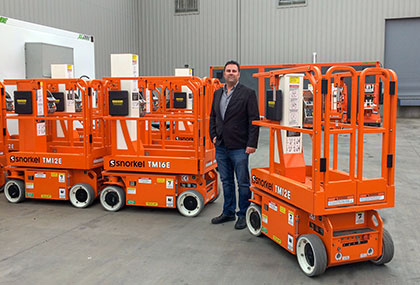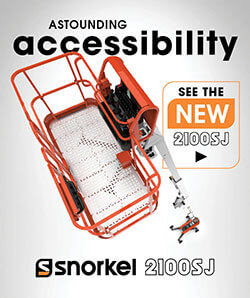
The new ANSI/SAIA A92 standards are a suite of complementary standardizations that cover the design and testing, safe use, and training for mobile elevating work platforms (MEWPs). These requirements are based on ISO 16368:2010, which is put forth by the International Organization for Standardization (ISO).
Accredited by American National Standards Institute (ANSI), for the U.S., the new ANSI/SAIA A92 standards applies to American MEWP manufacturers; as does the EN280 in Europe, AS1418.10 in Australia and CSA B354.6 in Canada. While each set contains some unique regional requirements, machines that comply with the standards generally can be sold and operated in most major markets worldwide.
Published on December 10, 2018, the new A92.20/.22/.24 standards will become fully effective on December 10, 2019. Deviating from the previous standards published in early 2018, the new suite is not specific to one type of platform. A92.20 will encompass design and testing aspects for manual and self-propelled masts, scissors, booms and personnel lifts as well as underbridge MEWPs. The safe-use standard, A92.22, and training standard, A92.24, will also apply to all these types of aerial equipment.
Under the new standards, aerial equipment is categorized as a Group A or B, and further as a Type 1, 2 or 3. Group A machines have platforms such that the center of the platform area, in all configurations and inclinations, never moves beyond the tipping lines. Group B consists of machines that do not meet the requirements of Group A.
In general, most scissor lifts meet the requirements for Group A. Conversely, most boom lifts do not, and are therefore categorized as Group B. Type 1 MEWPs, which could be self-propelled, push-around or trailer-mounted mast lifts, only permit travelling in the stowed position. Type 2 MEWPs have travel controls located on the chassis, and Type 3 have travel controls located at the operator work station in the platform. Most Snorkel lifts are in the Type 1 or Type 3 category.
Stricter testing and calculation requirements under A92.20 include factoring for wind loads, and dynamic and manual forces that may be exerted on machines. Designers must calculate and apply these loads through testing mandates to determine compliance. While these design requirements could result in changes to machine weight, operation would not be affected.
More noticeable physical changes to equipment design include enhanced stability requirements for platform load sensing systems on most machines. A platform load sensing system monitors and alerts operators if the rated platform load has been exceeded.
The standard requires that the platform load sensing system to trigger an alert after the rated platform is reached but prior to the platform load reaching 120% of the rating. It further requires that a warning consisting of a flashing red light and an acoustic signal be activated for a minimum of five seconds every minute for as long as the overload persists. The load sensing system is not required to stop movement if the overload occurs during movement, the system shall prevent any movement if the platform is stationary.
Certain machines with small platforms must meet enhanced stability and overload criteria in lieu of a platform load sensing system, and only a small number of machines will not require platform load sensing.
There are no solutions defined by the standards for how the platform load sensing systems must function or what type of apparatus is utilized as long as the criteria is met. This method allows equipment manufacturers to be creative and innovative in technology and design.
The new standard also increased the minimum requirement for handrail height from 39 in. to 43.3 in. (0.9m to 1.1m). Many models are manufactured with fixed handrails and a stowed height below 79 in. (2.0m) to easily fit through standard doorways. To comply with the new standards, such models may need to be redesigned with folding handrails. This change could increase both cost and complexity, and will most likely affect scissor lifts with a maximum platform height of 19 ft. (5.7m), one of the most highly produced MEWP units.
Also affecting scissor lifts is a restriction on flexible entrances, such as chain entrances. Instead, aerial lifts must be designed with gravity gates, swing gates or saloon gates. Snorkel lifts eliminated chain entrances in 2014 and produce all scissor lifts with saloon¬-style swing gates as standard.
Toeboards are now required at the entrance of all boom lifts. This is already available as an option on Snorkel boom lifts to comply with various international standards. And newly designed boom lifts will include a toeboard at the entrance to meet requirements.
Pneumatic, or air filled, tires will likely become less common with the new standard, which requires any pneumatic tire equipped machine to undergo flat tire testing or be equipped with a tire pressure monitoring system to ensure that stability is maintained in the event of tire deflation. Most machines will likely be equipped with foam filled or solid tires to easily comply with requirements. Snorkel has been offering primarily foam filled and solid tires since 2016 to meet growing demand.
Slab operated scissor lifts and mast lifts, among several other MEWPs, may be rated as indoor use only under the new standard due to wind loads. This does permit lighter machine weights for compact, indoor-rated machines. Any machine operating outdoors or in areas of potential wind load must undergo calculation and testing to ensure stability in up to 28 mph (12.5m/s) winds.
In addition to the previously required tilt alarm, MEWPs must prevent certain movements from reaching the limits of chassis inclination. Due to new requirements for stability and structure evaluation, some machines may have different tilt limits than previously permitted. As such, operators must be familiar with the operating parameters of compliant equipment.
Finally, the new standard sets limits on the function speeds of MEWPs. The maximum speed is based on a single function and the speed at which the operator will move. If the accelerations and decelerations are low enough, the speeds may be set to a higher limit. The previous standards did not have any maximum limit on function speed; it was merely determined by operator comfort.
About the Contributor
Jeffrey Eckhardt, P.E., is the vice president/chief engineer of Snorkel and Xtreme Manufacturing where he oversees new product development, product safety and international standard compliance. He is also currently on the ANSI A92 committee.



